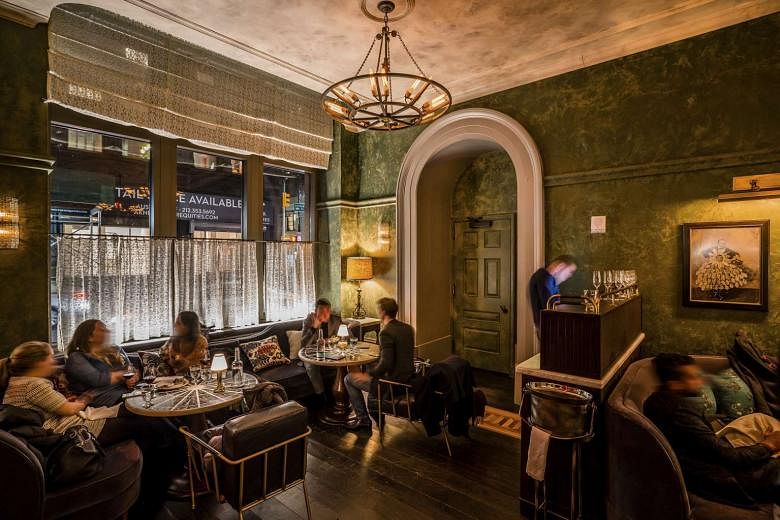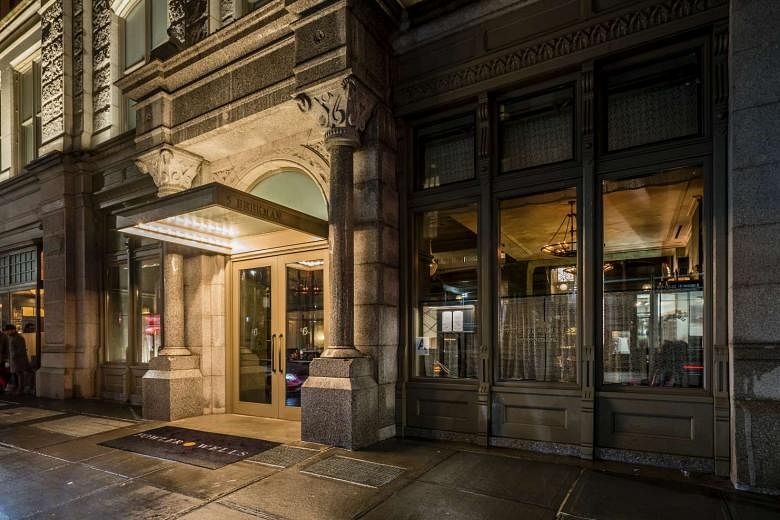NEW YORK (NYTimes) - A couple of years ago, I was eating dinner in a new restaurant on the Bowery. On the surface, Bacchanal was a pretty sophisticated operation. The chef, Scott Bryan, had once earned three stars from The New York Times; the bartender was pouring almond-fat-washed rum and other state-of-the-art booze; the sommelier wore a silk pocket square and a tie bar as he offered thoughts on a wine list that casually ambled up into four-figure territory.
Then I went to the restroom. A server pointed me toward a narrow, dark staircase whose steps were splotched with white paint.
Inside the restroom was a row of stalls. They were unusually small, and the tight squeeze was made worse because part of the space was taken up by a metal rod holding five or six spare rolls of toilet paper.
It was a real record scratch/freeze frame moment. And if you're wondering how I ended up in that situation, it's simple: I was eating in a hotel.
Bacchanal is closed now, but it wasn't the first or last place I've gone over the past few years where I needed to take a short stroll before I could powder my nose. There is a graceful, elegantly lighted staircase at the NoMad in the hotel of the same name, and a vertiginous, coal-cellar-steep one at Narcissa in the Standard hotel in the East Village. At Augustine and Fowler & Wells, the staircase is reached by traversing the Beekman hotel's crowded lobby bar and then circumnavigating a long bookshelf.
These walks and others gave me a lot of time for quiet contemplation, and eventually I started to wonder: If I live in New York City, why am I spending so many nights inside hotels?
I haven't counted the hotel restaurants that have opened in the city during my time as restaurant critic. I do know that there are a lot, and some even manage to situate their restrooms relatively close to the dining room.
The list would include places operated by some very well-known chefs: Mario Batali, April Bloomfield, Mario Carbone, Andrew Carmellini, Tom Colicchio, Tim Cushman, John Fraser, Daniel Humm, George Mendes, Harold Moore, Dale Talde, Rich Torrisi, Laurent Tourondel and Jonathan Waxman.
Danny Meyer, who is more famous than any of his chefs, has opened several hotel restaurants in that time, as has restaurateur Stephen Starr. Keith McNally and his Brooklyn equivalent, Andrew Tarlow, have each founded ones of their own.
While hotel restaurants are sprouting up around the country, in New York they have a particular local flavour, shaped by real estate forces and the fact that, unlike Las Vegas or Miami, the city rarely imports chefs. In effect, an entire class of restaurant - the big, mainstream, chef-owned, customer-friendly places whose profit margins have been shaved as thin as a chive over the past few years - is now being subsidised by the hotel industry.
To understand why, it helps to know something about the boutique hotel boom. As opposed to the big chain hotels that promised consistency with few surprises, this new wave of hotels tries to tailor each property to its setting.
They recognise that these days "when we travel, we want unique and authentic experiences", in the words of Henry H. Harteveldt, whose Atmosphere Research Group analyses the travel industry.
This rules out the cookie-cutter dining rooms of the big chains, but it also means a turn away from an earlier style of hotel dining: the curtained, carpeted, cushioned and cloched pomp of restaurants such as Alain Ducasse New York or Lespinasse.
"The boutique hotels wanted to be cutting-edge," Harteveldt said. "They viewed their food and beverage outlets as not just something to offer the guests, but true sources of pride and profit." One trouble with startup hotels, though, is that their names don't mean much on their own. The boutiques solve this problem by courting people whose names do have some currency.
Signing up a known chef "allows the hotel instant recognition", Batali wrote in an e-mail. Batali, an old hand at running restaurants in Las Vegas hotels, opened La Sirena in the Maritime Hotel in Chelsea last year. "For the hotel, the food and beverage program is the lifeblood of selling rooms." I had some vague idea of all this, but I didn't realise just how valuable chefs are to hotels until I learnt about the terms of a typical deal."
"The hotel pays for everything," restaurateur Ken Friedman said.
Everything?
"They build the restaurant for you," said Friedman, who is Bloomfield's business partner. "They say, 'What do you think it's going to cost for chairs and tables and lighting?' They pay for it all." This means taking care of the architects and contractors and graphic designers; the stoves and refrigerators; the hoods and air-conditioners and chandeliers. Most hotels will even help cover the publicist's bills.
For an independent restaurant, these initial expenses can quickly add up to US$1 million or more. This is not the kind of cash that chefs normally keep stashed in an apron pocket next to the meat thermometer, so they borrow from family, friends, banks or other investors. Some of them drown under the weight of this early debt.
Not the ones in hotels, though.
"We start making profit from day one," Friedman said. "That's almost impossible in the restaurant business." Once the tables are filled with customers, restaurants typically get a cut of the gross sales and then, once costs are subtracted, about half the profits. The percentages vary, but it's easy to see why so many chefs would rather go into business with a hotel than pay rent to a New York landlord, a breed that can be like an iron fist in an iron glove.
"The landlord has a number and that's the number," said the chef Wylie Dufresne, who will open a doughnut shop at the William Vale hotel in Brooklyn this spring. "If you can't pay it, the next guy will. A hotel can say, 'Okay. I've got a chef with a name that's going to draw people here and that's going to help fill my hotel and we can strike a slightly more agreeable bargain." If, a few years on, the restaurant isn't filling rooms and drawing local residents like it used to, the hotel may sign up a different operator. But for many restaurateurs, this is less agonising than investing money and time in a space and then having to walk away because the rent has quadrupled.
"This is a no-brainer for restaurants," said Ms Jasmine L. Moy, a lawyer in New York who negotiates hotel restaurant contracts. "If they can get these deals, they take them." Chefs in the city are quick to complain that independent restaurants are being strangled by soaring rents and creeping payroll costs; meanwhile, the smaller spaces they may be able to afford can be nearly impossible to set up in a way that satisfies the city's health and building codes. For many restaurateurs, hotels look like the only way out."
Or, as Ms Moy puts it, "The future of dining is going to be in hotels".
If she is right, then New York's future is going to look a lot like its past. Because these new hotel restaurants look and feel the way restaurants did in the 1990s.
The dining rooms are given serious square footage, which comes as a relief for those of us who have spent too many nights wedging our oversize frames into former bodegas on the Lower East Side. The tables are well spaced, and there are generally plenty of them. Reservations are taken and are generally not too difficult to come by.
Carmellini calls Leuca, which he opened last hear in the William Vale hotel in Brooklyn, "our most adult restaurant". "You can make reservations," he continued. "There's a lot of room. And the space drove that." Hotel menus offer loads of options. Tasting menus are rare, and when they exist they are concise and optional, not an evening-long mandate. Except in the very few places that run on licensing deals, the chefs are fairly hands-on and stay that way after the opening blitz. This means that the food will be, at a minimum, pretty good. At Dirty French, the NoMad, the Breslin, Le Coucou and the Clocktower, among others, it is much better than that.
The hotel industry's financial support of old-fashioned amenities is good news for restaurateurs who still believe in traditional hospitality, as well as for diners whose idea of a nice night on the town involves comfort, convenience and choice.
But the hotel restaurants also bring back other memories that I'm less nostalgic for. Almost none of New York's female chefs have been admitted to the party; Bloomfield, who runs four of them with Friedman, is an exception. Are the deals not coming their way or are women turning them down?
The cuisines that have flourished in the newer hotels are ones that New Yorkers were very familiar with 30 years ago: Italian, French and what used to be called New American. True, we have Indian Accent in Le Parker Meridien, but other large countries - for that matter, entire continents - have been left behind.
We can enjoy the hotel restaurants we've been given while wishing the industry had a broader vision that matched New York's wide-ranging appetite. Imagine if an adventurous company lavished its resources on street food and transformed its lobby into, say, a Singaporean hawker's market.
But this might conflict with one of the imperatives of hotel kitchens: room service. Chefs are almost always required to provide it, even if the orders for plain spaghetti for the kid on the eighth floor drive them crazy. For now at least, New Yorkers have some better choices for breakfast, which almost all of the hotels serve.
As for those long, exploratory trips to the restrooms, I finally have an explanation. I asked Mr Allen Gross, the chief executive of GFI Capital Resources Group, the real estate group that developed the Beekman, the NoMad and the Ace, and he sounded delighted that I had noticed. They were not an inconvenience, he said - they helped make the restaurants "an experience". He clarified the point in an e-mail: "By putting the restrooms in a different location, it gives us the opportunity to have the guests experience the hotel and gives them the opportunity to see the other restaurants, the atrium and the space as a whole." And now, when nature calls during dinner, you have a new way to excuse yourself. Just tell everybody you have an opportunity waiting for you in the basement.


